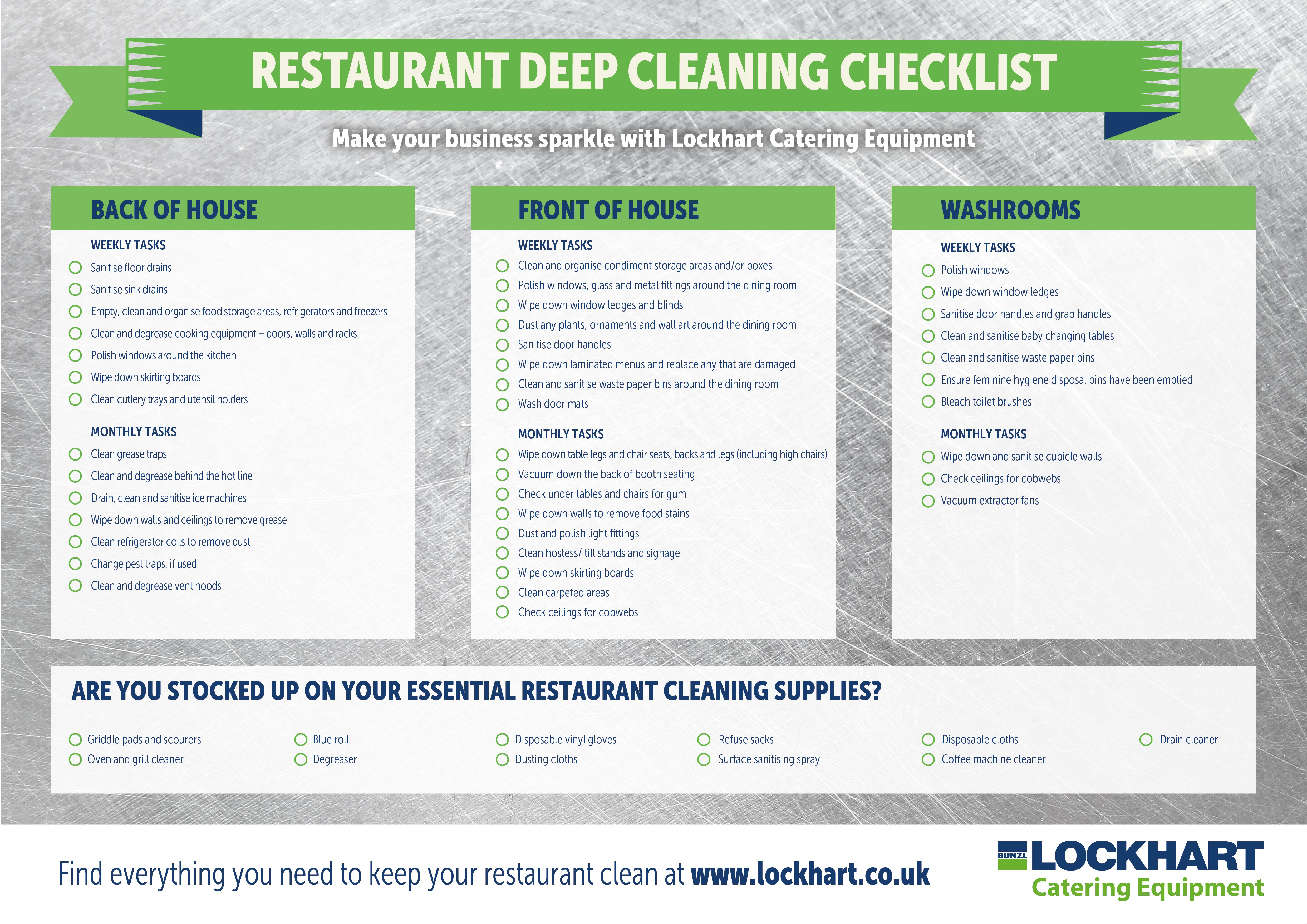Any restaurant understands the importance of cleanliness and sanitisation in running a successful business – with the Hospitality Industry set to reopen on the 12th April it is crucial more than ever to make sure your establishment is clean and hygienic, ensuring the health and safety for customers and hard-working staff.
Restaurant Deep Cleaning Checklist Template

We have put together a Restaurant Deep Cleaning Checklist to aid you when undertaking regular cleaning procedures, the thorough cleaning of restaurants and all other types of food businesses ensures compliancy with the food hygiene regulations and laws set out by the Food Standards Agency. We advise that in addition to your daily cleaning schedule, regular deep cleans in restaurants are also important.
Download The PDF Guide Here:
Why Should I Deep Clean My Restaurant?
Commercial deep cleans pay attention to those nooks, crannies, fixtures, and fittings that do not always warrant a daily cleaning. Restaurant tables and kitchen work surfaces need to be always kept clean and hygienic, of course, but tasks such as dusting light fittings, and cleaning kitchen windows and disinfecting drains, are not essential for every day.
Deep cleaning will also actively help to prevent build-ups of dirt, grime and grease that could shorten the lives of restaurant kitchen equipment and catering appliances, or even make them dangerous – to name but one example, excessive grease-build ups can be a fire hazard in a busy restaurant kitchen.
Why Do Restaurant Customers Value Cleanliness
Food hygiene ratings have greater influence over a diner’s choice of venue than customer service, according to research by food safety management company Checkit.
According to BigHospitality, 75% of consumers they surveyed would never visit a food establishment if it had been implicated in a food poisoning or hygiene incident. This shows the importance of cleanliness within a restaurant, however more crucial than ever due to the pandemic as consumers will be more wary of where they choose to eat. This is where our Restaurant Deep Cleaning Checklist comes in to help, it will ensure your restaurants hygiene is at the highest standard that consumers value.
Six Steps for an Efficient Restaurant Deep Clean
- Plan and Prepare
- Make sure you have the right equipment
From disposable gloves to wet floor warning signs and of course plenty of blue roll, an effective deep clean can only be carried out when you have sufficient and appropriate cleaning products and equipment. Before your weekly and monthly deep cleans are due, check your supplies so that your staff are all well-prepared. Check out our COVID-19 Cleaning Essentials Here
- Allocate tasks fairly
With the help of our restaurant deep cleaning checklist, you will be able to distribute tasks among your staff fairly to ensure that everyone has a balanced workload. And once the jobs are complete and all ticked off, remember that a beer or two ‘on the house’ is always well-received!
- Clean first, then sanitise
A fact that is often overlooked when cleaning is that disinfectant products are only effective on clean surfaces! All visible grime and grease need to be removed with an appropriate cleaning chemical before a surface can be sanitised. This can make cleaning take a little longer, but it is an important step not to overlook.
- Cover or move all your food
Whether in the front or house dining room or in the back of house kitchen, all food products and ingredients must be moved or safely covered before cleaning tasks are carried out, to prevent them being contaminated.
- Employ a professional cleaning service if needed
If the thought of spending hours on a deep clean is too daunting, or you feel that some equipment or areas (such as deep fryers or hood vents) are too difficult for you to clean yourself, it is best to employ a contract commercial cleaning company to do the hard work for you.
Carrying out a restaurant deep clean requires a certain amount of planning. For a weekly deep clean, it’s recommended to schedule these tasks for a time when the restaurant is closed – such as a Sunday or Monday morning – or at least when it is very quiet. Some cleaning tasks can also be messy, so you may not wish to carry them out in front of your restaurant guests.
For a monthly deep clean, which can take hours or more, ensure this is planned some time in advance and that you schedule enough members of staff to tackle it as quickly as possible.
As well as our commercial kitchen and restaurant deep cleaning checklist, you may find the Food Standards Agency’s Safer food, better business for caterers’ information useful in helping you comply with food hygiene regulations. You can also read more about raising your kitchen hygiene standards, and increasing your chances of getting a high food hygiene rating, in our blog post, Are You On the C.A.S.E. to Improve Your Restaurant Kitchen Hygiene?




Leave a comment